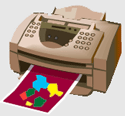There was a story in the Los Angeles Times today concerning printer cartridges and the difficulty that consumers have in trying to determine the amount of ink that they contain. According to the LA Times story, the next meeting of the National Conference on Weights and Measures (NCWM), a not-for-profit corporation dedicated to developing the U.S. standards for weights and measures, is going to try to make it easier for consumers to find out.
But the task may not be an easy one.
It seems that printer manufacturers don't think consumers have a right to know how much ink are in their cartridges and are none too happy that NCWM is even considering that printer cartridges be required to state the amount of ink they contain on their packaging.
The manufacturers claim that the amount of ink in a cartridge is an "inappropriate" and "misleading" way of providing information to consumers since the type/quality/number of images being printed varies so much, and printing frequency can significantly change the number of images that can be printed.
Furthermore, the amount of cartridge ink is a very small portion of the total cost of the overall print cartridge mechanism, they argue. So providing the information would not be helpful to consumers in comparing different manufacturers' cartridges. I may be missing something, but most of the ink jet cartridges I use don't look too mechanically complex to me.
The manufacturers also claim that ink cartridges have been exempt from the Fair Packaging and Labeling Act for decades, and now is not a good time to change. But according to the Times story, the National Institute of Standards and Technology says that isn't true, and that cartridges need to state a "liquid measure" to comply with its regulations.
Finally, the manufacturers go on to claim that their estimate of the number of pages a cartridge will generally yield - based on an International Organization for Standardization (ISO) methodology under ISO/IEC 24711 - is good enough.
HP describes how it determines yield here.
Of course, my printer software doesn't keep track of the number of pages I print or the number of cartridges I replace so I can't really tell what my average yield is, which would let me compare my average printer yield against a manufacturer's stated yield. Maybe there is software available that does this already, but I don't know of any off hand.
A 2003 story in PC World calculated HP ink was sold at $88 per ounce, or some $11,264 per gallon. I don't think it has changed much since then. The American Consumer Institute Center for Citizen Research claims that "giving all (US) consumers more information on the cost of printing and printer ink would help them to make well-informed purchasing decisions and save $6 billion per year," a figure the printer manufacturers dispute.
It would be interesting to see what would happen to cartridge prices if the sellers of printer cartridges were required to post a price per ounce or better a price per gallon label.
Anyway, the NCWM meeting is next week in Nashville, Tennessee. Maybe the LA Times will do a follow-on story to find out what the outcome is.
Robert N. Charette is a Contributing Editor to IEEE Spectrum and an acknowledged international authority on information technology and systems risk management. A self-described “risk ecologist,” he is interested in the intersections of business, political, technological, and societal risks. Charette is an award-winning author of multiple books and numerous articles on the subjects of risk management, project and program management, innovation, and entrepreneurship. A Life Senior Member of the IEEE, Charette was a recipient of the IEEE Computer Society’s Golden Core Award in 2008.



